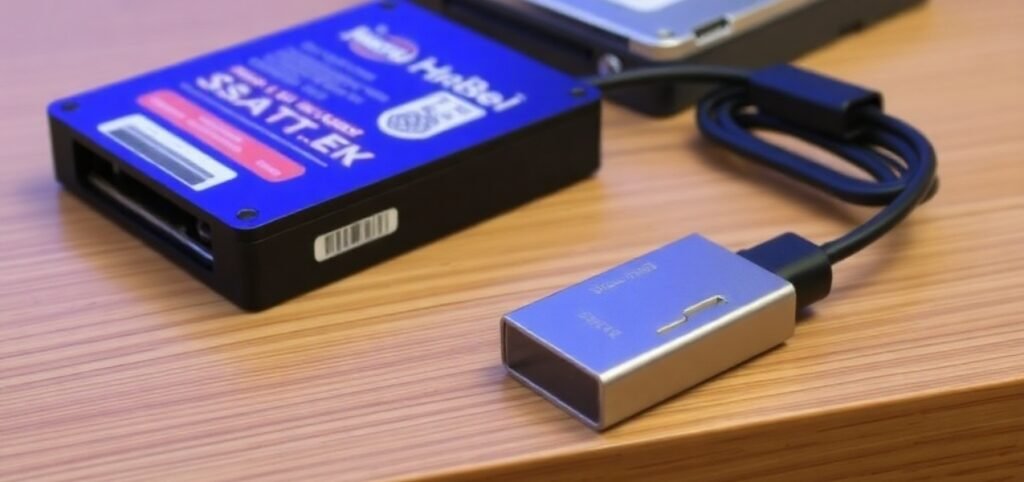In today’s digital age, managing and accessing data efficiently has become more important than ever. Whether you’re a tech enthusiast, a professional managing large files, or someone who simply needs to recover old data, using a SATA to USB adapter is a game-changer. This compact and versatile tool can help you unlock the full potential of your storage devices. Let’s dive into how SATA to USB can simplify your life and maximize your storage solutions.

What is SATA to USB?
Before we explore the benefits, let’s start with the basics. SATA (Serial ATA) is the standard interface used to connect storage devices like hard drives and SSDs to your computer. USB (Universal Serial Bus) is the most common interface for connecting devices to a wide range of gadgets, including laptops, desktops, and even smart TVs. A SATA to USB adapter acts as a bridge, allowing you to connect internal storage devices externally via a USB port.
Why Do You Need a SATA to USB Adapter?
- Data Recovery: Imagine you have an old laptop or desktop that no longer works, but you need the data stored on its hard drive. A SATA to USB adapter allows you to easily connect the internal hard drive to another computer, making it simple to recover important files.
- Upgrading Storage Devices: When upgrading your computer’s storage, you can use a SATA to USB adapter to transfer data from the old drive to the new one without hassle. This is especially helpful for cloning drives or performing backups.
- Testing Drives: If you’re a tech professional or DIY enthusiast, a SATA to USB adapter is essential for testing hard drives and SSDs without having to install them inside a computer. This saves time and effort, especially when diagnosing storage issues.
- Portable Storage: With a SATA to USB adapter, you can turn any internal hard drive or SSD into an external drive. This is an affordable way to repurpose old drives and expand your storage capacity without buying a new external hard drive.
Key Features of SATA to USB Adapters
- Universal Compatibility: Most SATA to USB adapters work with 2.5-inch SSDs, 3.5-inch hard drives, and even some optical drives, making them versatile for various storage needs.
- Plug-and-Play Design: Setting up a SATA to USB adapter is straightforward. Simply connect the SATA drive to the adapter, plug the USB cable into your computer, and you’re ready to go—no complicated installations required.
- Fast Data Transfer Speeds: Modern SATA to USB adapters support USB 3.0 or even USB 3.1, ensuring high-speed data transfers. This means you can move large files like videos, photos, or backups in no time.
- Power Support: For larger drives that require more power, some SATA to USB adapters come with an additional power cable or adapter. This ensures reliable performance even with high-capacity drives.
Benefits of Using SATA to USB
- Cost-Effective: Instead of buying expensive external drives, a SATA to USB adapter lets you reuse old internal drives, saving money while reducing electronic waste.
- Convenience: With a SATA to USB adapter, you can easily access data from different drives without needing a dedicated docking station or enclosure. This portability makes it an essential tool for on-the-go professionals.
- Data Security: If you’re concerned about sensitive information stored on old drives, a SATA to USB adapter allows you to securely access, transfer, or erase data without handing over the drive to a third party.
How to Use a SATA to USB Adapter
Using a SATA – USB adapter is simple:
- Connect the Drive: Attach the SATA connector of the adapter to your hard drive or SSD.
- Power the Drive (if needed): If you’re using a 3.5-inch hard drive, connect the additional power adapter to ensure it works properly.
- Plug in the USB: Insert the USB connector into your computer.
- Access Your Data: Once connected, your computer should recognize the drive as an external storage device. You can then transfer, recover, or back up your data as needed.
Choosing the Right SATA to USB Adapter
When selecting a SATA – USB adapter, consider the following:
- USB Version: For faster data transfer, opt for adapters with USB 3.0 or USB 3.1 support.
- Drive Compatibility: Ensure the adapter supports the type of drive you intend to use (2.5-inch SSD, 3.5-inch HDD, etc.).
- Power Options: If you’re working with larger drives, choose an adapter with a reliable power source.
- Build Quality: A durable and well-designed adapter will last longer and provide more reliable performance.
Conclusion
A SATA – USB adapter is a simple yet powerful tool that can revolutionize how you manage your storage devices. Whether you’re recovering data, upgrading your computer, or repurposing old drives, this versatile adapter makes the process seamless and efficient. With its affordability, ease of use, and wide range of applications, a SATA – USB adapter is a must-have for anyone looking to maximize their storage solutions.
Invest in a SATA – USB adapter today and experience the convenience and flexibility it brings to your digital life. It’s a small device that can make a big difference!
